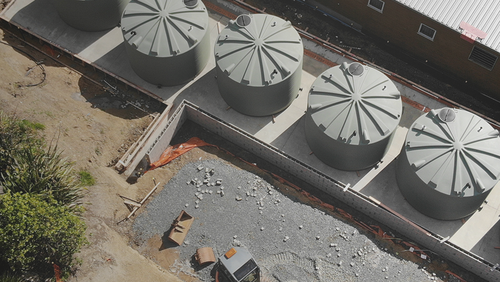7 Oct 2025
Seismic strengthening and replacement of building services in the country’s largest and busiest court complex is underway, all while the building remains fully operational.
The Ministry of Justice’s Auckland District Court was built in 1985 and provides 28,000m2 of floor space within a five-level podium structure and nine-storey tower above. Today, it’s Aotearoa’s busiest court complex. With 33 courtrooms, it handles hearings six days a week, some of which are scheduled 12 months in advance. It is critical infrastructure that can’t simply shut down for renovations.
“We’ve got to keep this place running while we completely rebuild it from the inside out,” says Glenn Ellis CMEngNZ CPEng, Technical Director, Building Services Kaitohu Hangarau at WSP.
The scope of this remediation project focuses on installing new elements to improve the seismic resilience of the concrete structure while also improving energy efficiencies through building services. Physical work started on site in June 2024 and is expected to be completed by the end of 2028.
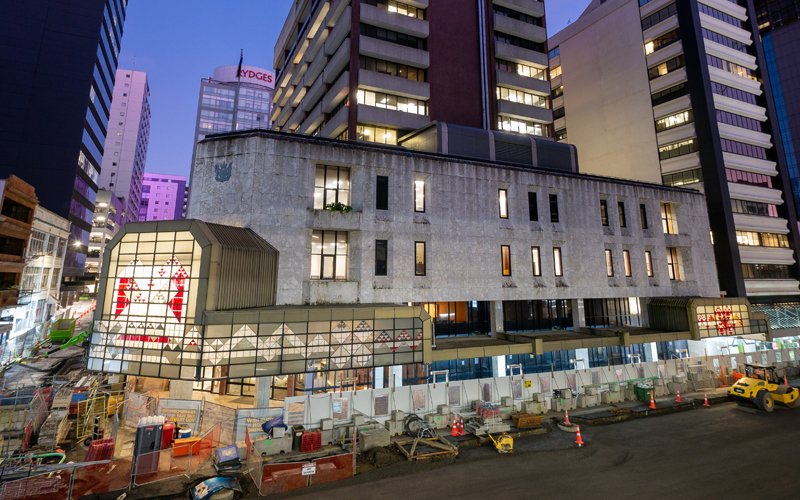
Auckland District Court. Photo: Crown Infrastructure Delivery
The project is being led by Crown Infrastructure Delivery, the specialist infrastructure delivery agency that partners with other government agencies to support the delivery of large-scale construction projects around the country. WSP is the primary engineering consultant and LT McGuinness is the main building contractor.
Senior project manager at Crown Infrastructure Delivery, Rhett Calvert MEngNZ, explains how the project was approached: “We deliberately stacked this project with engineers from top to bottom – steering committee, project control group, even the construction team. When you’re opening up ceilings and finding problems that need solving immediately, you need engineers who can solve complex issues fast.”
With engineers across all disciplines – structural, mechanical, electrical, fire, acoustics and lighting – the team operates in scheduled shifts. Daytime is for meetings, inspections and planning. Drilling and other noisy activities can only take place from 6.30pm to 6.30am, to ensure that staff and visitors to the courts remain unimpeded.
“Courts are demanding environments, including the need for speech intelligibility and audio recordings,” Rhett explains.
“Noise during a trial can lead to a trial being postponed. Any drilling into the structure has to occur outside operating hours.”
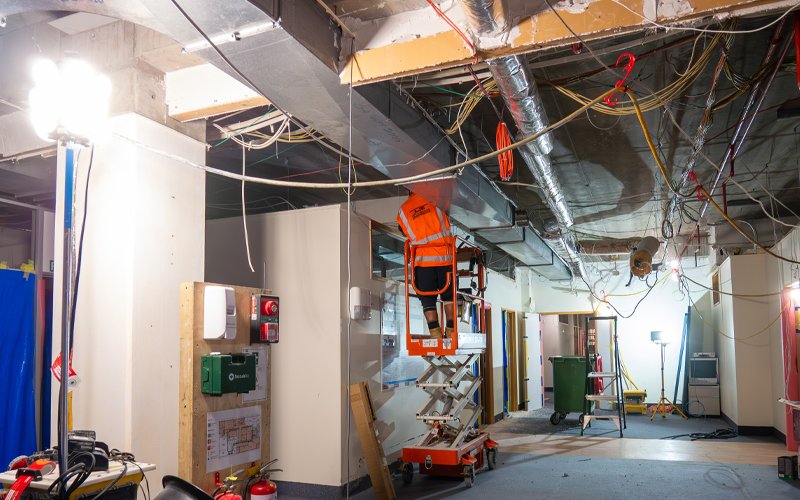
A tidy up of existing power and cabling infrastructure. Photo: Crown Infrastructure Delivery
This project broke new ground by becoming one of the first large developments to use the new NZS 3910:2023 engineering construction contract standard, updated in collaboration with Engineering New Zealand. And the team has taken a forward-thinking approach to seismic design. The building is being upgraded from a Grade C seismic rating, which is typical for most existing structures, to a Grade A standard.
“Design work was underway during changes to Section C5 of the Non-Earthquake-Prone Building Seismic Assessment Guidelines,” explains Carl Ashby FEngNZ CPEng, WSP’s Structures Director, who was part of the committee developing the new standard.
“We incorporated the latest C5 outcomes into our project before C5 was officially ratified. This has effectively future-proofed the building for the next 50 years.”
Access to the building is another key issue.
“Courts have several separate circulation paths for the public, the judiciary and the defendants, which cannot cross over each other,” Rhett says.
“Keeping all these circulation paths available has presented significant challenges.”
The solution involved a six-stage approach, creating temporary spaces outside the building, fitting them out, and relocating staff when necessary, in order to bring in the new infrastructure and remove the old. This allowed entire floors to be taken offline in the Court Tower, avoiding a half-floor approach.
With work in the Court Podium, Glenn says: “We’re building new infrastructure alongside existing infrastructure to allow all spaces to remain operational. Only when all spaces on a floor have been connected to the new central systems can we come back and demolish the old infrastructure.”
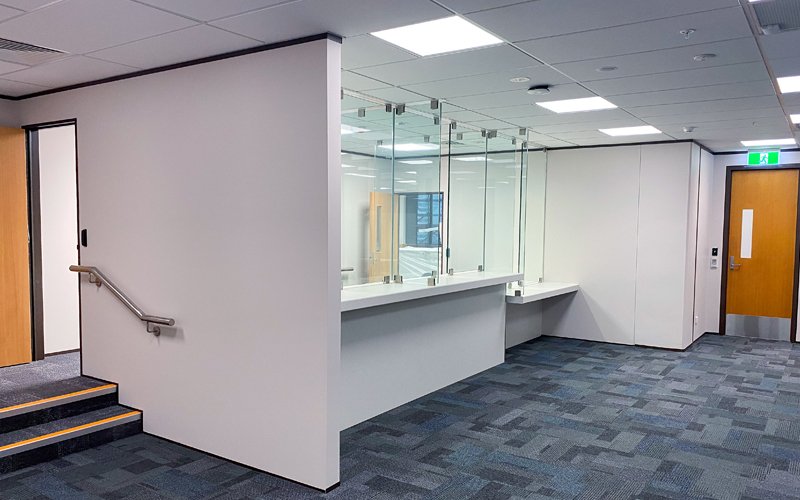
Refreshed registry counter for the public. Photo: Crown Infrastructure Delivery
Beyond seismic upgrades and building services enhancements, the project also embraces decarbonisation and sustainability measures. One of the project’s most innovative aspects focuses on air quality, by implementing fresh air rates that are 50 percent higher than the Building Code minimums.
“High fresh air rates are proven to improve occupant alertness, critical in a courts environment where the judiciary and jury must focus on the case being presented,” explains Glenn. “Reduced sickness through higher fresh air rates is also attractive to staff.”
The engineering solution uses demand-control ventilation with real-time air quality monitoring.
Glenn says this means they can get increased rates to spaces where they are needed while maintaining a lower overall rate, balancing peak performance with energy efficiency.
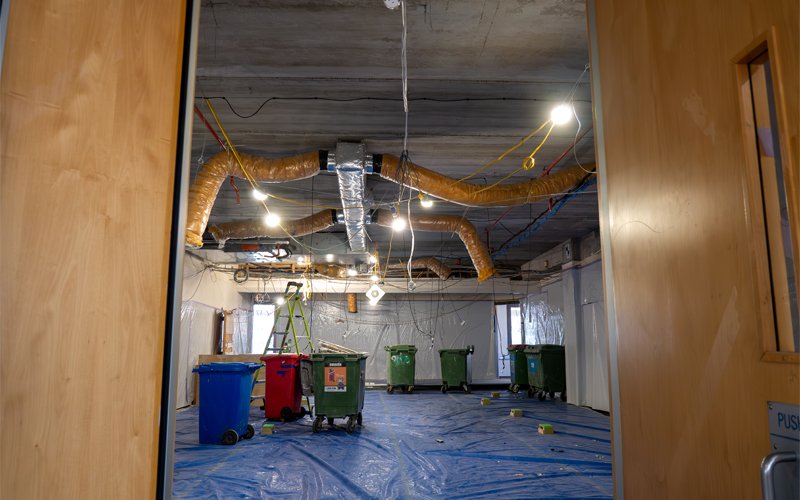
Existing in-ceiling services were removed to allow installation of new fresh air ducting. Photo: Crown Infrastructure Delivery
“The decision to upgrade and maintain the building, as opposed to building new, has had a tremendous saving in embodied carbon,” says Glenn. Additional sustainability measures include LED lighting, occupancy sensors, low-emission electric heat pumps and comprehensive energy monitoring.
Rhett says the work by the Ministry of Justice’s decanting project team, with their knowledge of courthouse operations, has been crucial in facilitating delivery of the works. “For example, planning for the temporary relocation of 90-plus registry staff to other floors, and of the six floors either completed or underway.”.
Ministry of Justice’s Group Manager, Courts and Tribunals Regional Service Delivery Jacquelyn Shannon says that despite the daily disruptions such as personnel relocating to other floors, temporary access restrictions to lifts and building entrances, and occasional noise, staff appreciate that the project has also enabled the remodelling of many spaces within Auckland District Court.
“Examples of this include the fitting out of a new non-custodial courtroom and the installation of a new public family and civil registry counter with improved staff safety features.”
With completion scheduled for the end of 2028, this project is an example of how innovative engineering can still happen while business-as-usual continues for those people who need it most.
This article was first published in the September 2025 issue of EG magazine.



